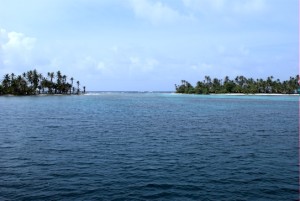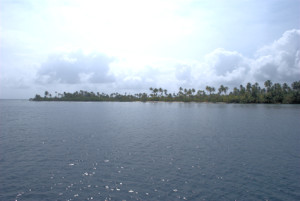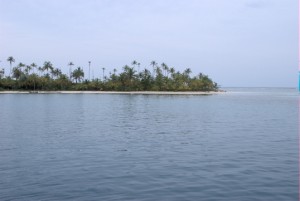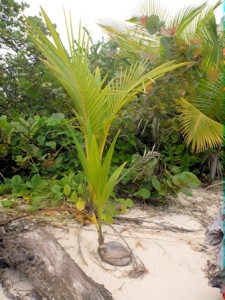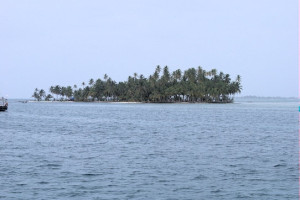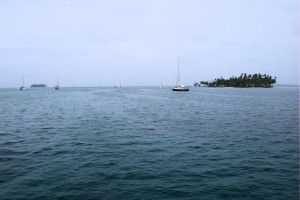July 2014: Shelter Bay Marina
Journey to the Free Zone
As we entered July, we decided that we would spend the summer based in Shelter Bay (there was something about that swimming pool) before heading north to Bocas del Toro for the rest of hurricane season. We really wanted to see the San Blas Islands, so we decided that while we were waiting for our next shipment of batteries to arrive, we would go there for a couple of weeks. Before that, we arranged with Teddy to go to the Colon Free Zone with Pete and Mary. We were expecting the world’s biggest outlet mall – but it was much different than that. Yes, it is huge, so we told Teddy what we were looking for, and he took us to shops that he recommended. Rosé and Mary wanted to get iPad Mini’s, Pete wanted a DSLR camera, we wanted to check out a liquor store, and I wanted to find the pet supply store PeDeSu that we failed to find in Panama City. We’ll start with PeDeSu – we called them, Teddy talked with them, and we came to believe they were in a separate part of the Free Zone. We also came to believe that they didn’t necessarily exist, and if they did, they would only be interested in selling pallets of dog food. We gave up on that one. Teddy took us to an electronics store run by some Indians that spoke perfect English, and we made some good deals for the iPads and camera. After that, we went to a liquor store. We were expecting giant duty-free liquor superstores, but they were just very small and cramped storefronts with display bottles and prices. As with the electronics store, the goods are kept in a warehouse somewhere – you place an order, and the goods are delivered a few minutes later. I think this is because many of the customers are from cruise ships, and the goods are delivered directly to the ship. Anyway, Mary was looking for a high-end bourbon, which didn’t seem to exist in Panama. We bought a few bottles of Bacardi at reasonable prices, as well as some soda cases. We also shopped at some sporting goods places – they had really inexpensive Nike wear and shoes everywhere. There were tons of watch and jewelry stores, as well as perfume – typical of cruise ship duty-free shops. Although the zone is supposedly for businesses and tourists, we saw many Panamanians shopping there. It was interesting to see, and the discounts on the electronics balanced out the fee for Teddy, but we wouldn’t go back again, unless we had an interest in specific big-ticket items. As a side note, Teddy brought his adorable son (four years old with him), and his van wouldn’t start when we were ready to leave – dead battery. Amazingly, we found enough people to push start it on a very crowded street.
July 12th, 2014: Shelter Bay Marina to Isla Linton
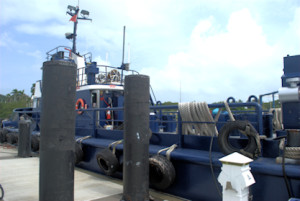 We left for the San Blas Islands on a bright and clear Saturday morning. We decided to take on fuel at the marina. As the last fuel we got was in Chiapas, Mexico. The price was reasonable, at $4.42 per gallon inclusive of tax. The marina doesn’t have a fuel dock, but it does have a fuel “barge”, which is a large tugboat with giant fuel tanks. It does pump a lot of fuel, and they give you a sample so you can see what you’re getting, so we were comfortable with it. We took on 500 gallons, which took about a half an hour.
We left for the San Blas Islands on a bright and clear Saturday morning. We decided to take on fuel at the marina. As the last fuel we got was in Chiapas, Mexico. The price was reasonable, at $4.42 per gallon inclusive of tax. The marina doesn’t have a fuel dock, but it does have a fuel “barge”, which is a large tugboat with giant fuel tanks. It does pump a lot of fuel, and they give you a sample so you can see what you’re getting, so we were comfortable with it. We took on 500 gallons, which took about a half an hour.
Good to go, we set out across Limon Bay to the breakwater, at last entering the Caribbean. We had read that cruising in the Caribbean would be a big shock after the Pacific, and the authors were right. In the Pacific, you generally have very long period swells, usually fifteen seconds or more apart. Even if there is a big swell running, you don’t really notice it as the waves have shallow slopes. In the Caribbean, the swells are wind-based, close together, and steep. As soon as we crossed through the breakwater, we started pitching and pounding with the swell coming in about 30° to our port bow. They weren’t big, at about three to five feet, but they definitely impacted our speed through water.
Since it was about seventy miles to the first of the San Blas Islands, we decided to stop at Isla Linton for a couple of days, where I would clean the bottom. It’s a popular and well-protected anchorage, and we heard there were some monkeys on the island. The anchorage was indeed crowded, and we sought a good place for a while. The “mayor” of the anchorage came by on a dinghy as were contemplating a spot, and chastised us not to drop the hook where we were considering – the reason escapes me now. It seems whenever there is an anchorage with some long-term boats in it, someone appoints themselves as the mayor. They are generally harmless, and it’s best to appease them. So, we moved a little bit to where the mayor recommended, and peace was preserved.
Position at destination: 9°36.7’ N, 79°35.3’ W
Air temp: 87 Humidity: 73% Water temp: 86.5
Nautical miles for this leg: 28.4 Total: 4549
Departed at 11:10am, arrived at 3:30pm
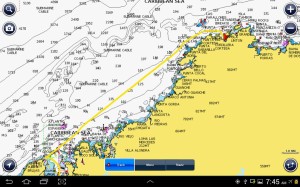
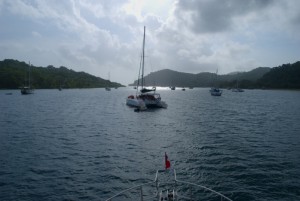
Our track to Isla Linton Looking west at the Linton anchorage
July 12th – 16th: Isla Linton anchorage
Shelter Bay Marina frowns on bottom cleaning in the marina, and the first time I went down using the hookah John came over to harass us, and Rosé told him I was checking on some damage. So, we decided to wait until we were out of the marina. We have an Airline hookah on board. It’s a gas-powered air compressor with two 60’ hoses meant for recreational diving. Since we aren’t SCUBA certified, and we didn’t want to carry tanks on board, we decided to skip SCUBA certification and go with a hookah. It allows you to do shallow dives as long as the gas holds out. It rides in an inner tube, and follows you as you dive the reefs. There is an electric version, but it’s strictly for dockside use. I learned how to use it while we were in Shelter Bay, so I was prepared to do the heavy-duty bottom cleaning work. I wasn’t prepared for the strength of the current that flows through the bay. I found that I needed to use the suction-cup grab bar to stay in place under water. There was a lot of hard growth, so clearly we needed to get the bottom repainted again. It took me eight hours over two days to scrape the entire bottom. I also took a look at the rock damage to the keel from back in Mexico, and I thought it looked pretty bad. An entire chunk of fiberglass was relatively loose – probably six inches long. Clearly, this was going to require fixing. While I worked on the bottom, Rosé cleaned around the waterline. When I finished, I realized there was no way that someone could clean the bottom with just a snorkel, so that was out for the future.
There was a catamaran just off our starboard bow with a group of people on it. Most of the boats anchored here were either unoccupied or long-term liveaboards. These people looked to be long-term. One of the guys was doing some painting, and his painting uniform consisted of the tiniest thong I had ever seen on a man – not something you want to see. There was another catamaran behind us, and the owners stopped by to invite us over for BYOB sundowners. It turns out they were friends with the mayor, who also came for sundowners with his wife. We don’t remember the name of the cat, but it was Hawaiian, owned by Harry and Linda. The mayor was Rob, with his wife Lauren, on board the sailing yacht Southern Comfort. We had a really nice time, and we learned that Rob and Lauren had extensively cruised the Bahamas, Puerto Rico, and the Virgins. At that time, our working plan was to go to Florida for Christmas, then quickly through the Bahamas and work our way down the Caribbean to Trinidad for summer of 2015. After a long discussion with Rob, we decided that we should spend a lot more time in the Bahamas, and the summer in Puerto Rico. He also recommended avoiding the Dominican Republic, due to the big hassles presented by corrupt officials. After a few drinks, we mentioned being entertained by the guy in the tiny thong on the cat in front of us. Rob said that he was French, and they called him “ball-sack”. You’ve gotta love cruiser humor…
We reciprocated and hosted the two couples on our boat the following night. We got a recommendation for a restaurant in the bay, and found out there was a dinghy passage through the mangroves to Panamarina, a large protected anchorage used as a storage facility. Harry and Linda had seen monkeys and sloths on that passage, so we t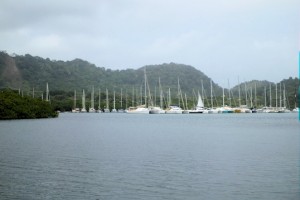 ried it the following day.
ried it the following day.
The river was deep enough for us to motor through it, with very clear water. We went through a tunnel of mangroves, searching for a sloth. Linda had shown us her pictures, where the sloth had come right down a mangrove to the water to poop – they had great close up pictures, although they did preserve the sloth’s dignity. We didn’t see any sloths, and soon we emerged from the river into the large Panamarina storage area. It was full of mostly sailing catamarans, moored tightly together. Apparently you can leave your boat here for the summer, and it is checked on periodically. We went back into the mangrove river, and soon Rose’s steely eyes spotted a sloth above us. It wasn’t real close, and it was in a hurry (if a sloth can ever be in a hurry) to get away from us, but we managed to snap a few pictures.
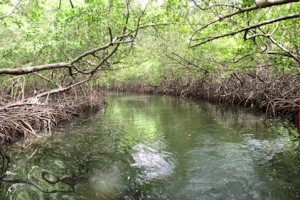
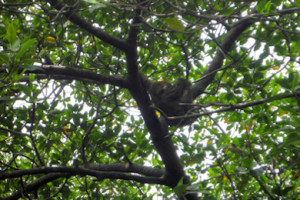
Mangrove river Sloth climbing a mangrove tree
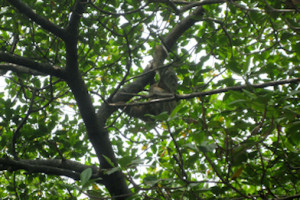
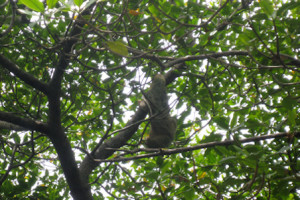
We managed to get a couple of more shots before the sloth completely blended into the mangrove tree
After finally seeing a sloth, we decided to go onshore for lunch at the tiny restaurant Rob recommended. We found the small restaurant which had a few lines set to secure dinghies. It was located to the right of the town dock. The owner was Dutch, and he had run the restaurant for ten or so years. The menu was on the wall. We both ordered the chicken dinner, which was a sautéed chicken breast, served with the best French fries we have ever had, the best coconut rice we had ever had, and salad. It was simply fabulous. Perhaps it tasted so good because we were pretty tired of the limited menu at the Shelter Bay restaurant, but damn, it was good!
July 16th, 2014: Isla Linton to West Lemon Cays
After a few days at Linton and with a clean bottom, it was time to get to the Kuna Yala (the native name for San Blas). We left early in the morning for the forty-five mile run to our first stop, the West Lemon Cays. The Bauhaus guide showed a pretty tricky entrance, so we wanted to be there at best light. It was a fairly smooth run, and we arrived at the reef around 1:00PM. We slowed to idle and Rosé took up watch on the bow. The guide was very accurate, and our plotted course worked out very well. We wanted to anchor off of Naguarchirdup Island, but we had a hard time finding the right spot. The depth varied wildly, and we didn’t know if the wind would be shifting. The flattest spots were taken up by mooring balls. We anchored one time, but after diving the anchor, we decided to try a different spot. We finally settled on a fairly flat spot at about 12’ of sand and grass – we weren’t used to anchoring in shallow waters, but we had no option. The anchorage was beautiful, nestled between several very small islands. The Kuna Yala islands are small, flat, sandy, and covered in coconuts. Typically, one family lives on a small island, and they own the coconuts, but not the island. One of the cays close to us had a makeshift bar on the beach – we guessed that they host day boats from time to time.
Position at destination: 9°32.7’ N, 78°54’ W
Air temp: 92 Humidity: 66% Water temp: 88
Nautical miles for this leg: 45.5 Total: 4594
Departed at 6:35am, arrived at 2:15pm
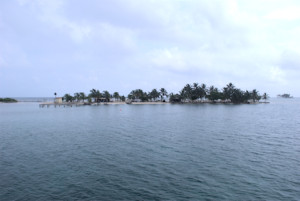
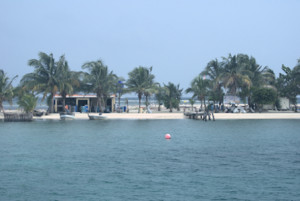
One of the many West Lemon Cays The beach bar

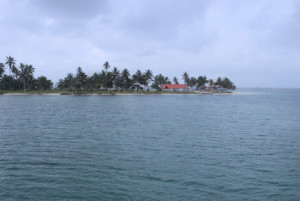
Naguarchirdup Island A very fancy Kuna dwelling
Shortly after we settled in, we were paid a visit from Lisa, the master mola maker. Lisa is a transvestite, which is fully accepted in Kuna culture. Lisa is one of two master mola makers in the Kuna Yala. She was in a cayuco (dugout canoe with an outboard motor) with a man and a small boy. She speaks excellent English, and she had a wide variety of molas to show us. We ended up buying several, both for gifts, and to make pillows with for the boat. We gave some candy to the boy, and we also bought a few lobsters for dinner, at $5 each. We were starting to enjoy the Kuna Yala!
July 17th, 2014: West Lemon Cays to West Holland Cays
The next destination on our short Kuna Yala cruise was the western side of the Holland Cays. Along the way, we passed a number of small islands that looked like something from a Castaway movie – small, sandy islands covered with coconut palms, some with settlements for the Kuna, as well as backpacker retreats.
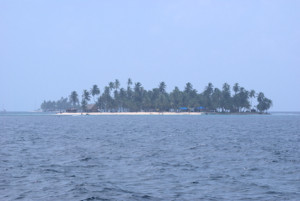
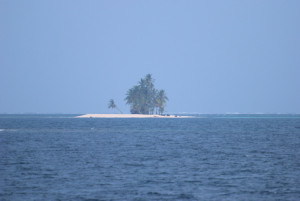
Some of the many small islands we cruised past
A little less than ten miles later, we arrived at our anchorage in the West Holland Cays. There was one other boat, a sailing cat, near us, and another boat anchored close to shore further east. We were anchored near a narrow opening between two cays, and we could see the reef through the opening.
Position at destination: 9°36’ N, 78°46.5’ W
Air temp: 90 Humidity: 77% Water temp: 87
Nautical miles for this leg: 9.6 Total: 4604
Departed at 10:30am, arrived at 12:10pm
We took down the kayak and paddled ashore. Although this was a relatively large cay, there were no visible settlements. We decided to go rogue and abscond with a coconut, as we were still trying to figure out how to make coconut rice. Technically, you aren’t supposed to take the coconuts, but seeing that there were tons on the ground and no settlement in sight, we figured it was okay. Plus, we had been visited by a cayuco when we arrived, and the Kuna requested a $15 “cruising fee” for anchoring in the Holland Cays. We also gave him some ice, so we believed we had paid for this coconut.
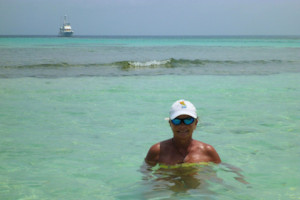
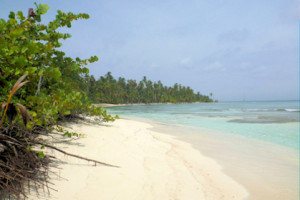
Rosé enjoying the water Deserted beach
We had a peaceful night at anchor. We tried to make the coconut rice by adding fresh shavings to steaming rice, but that was less than worthless – back to the recipe board. However, the lobsters were delicious. I learned that the secret for either grilling or sautéing them was to boil them in the shell for a couple of minutes, plunge the tail into cold water to stop the cooking, then remove the meat from the shells and complete cooking – yummy!
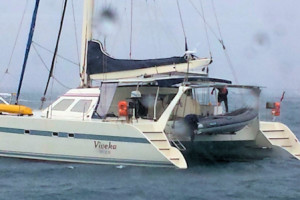 The next morning, I looked out and observed that there was a rainstorm approaching. About five minutes later, it hit us with a fury, winds gusting to 35 knots, and heavy rain falling almost horizontally. We saw that the guy in the catamaran near us had donned a wetsuit and was furiously scrubbing his boat – we laughed, but it was actually a good idea, although the wetsuit was a bit over the top.
The next morning, I looked out and observed that there was a rainstorm approaching. About five minutes later, it hit us with a fury, winds gusting to 35 knots, and heavy rain falling almost horizontally. We saw that the guy in the catamaran near us had donned a wetsuit and was furiously scrubbing his boat – we laughed, but it was actually a good idea, although the wetsuit was a bit over the top.
July 18th, 2014: West Holland Cays to East Holland Cays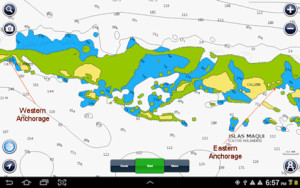
After the squall passed by and the boat washing show ended, we hoisted the anchor for the quick trip to the eastern Holland Cays, a more popular anchorage. It was a very smooth passage through the protected channel. We could see a lot of breakers on the reef, and there are some visible wrecks out there. There is a well-known anchorage called the Swimming Pool, but we decided to anchor off of Ogoppiriadup Island. This was relatively deep, at 20’, and a lot of space between reefs. We still weren’t used to shallow water boating.
Position at destination: 9°34’ N, 78°40.4’ W
Air temp: 84 Humidity: 68% Water temp: 86
Nautical miles for this leg: 6.9 Total: 4611
Departed at 10:15am, arrived at 11:30am
I went snorkeling on the reefs near the boat. I wanted to try out the Sea Life camera. We had gone through four Panasonic Lumix cameras – all of them leaked after a few uses. They were replaced on warranty, but we decided to never use it underwater again. Before we left on our voyage, we bought the Sea Life DC1400 camera and underwater housing for $500. It was highly recommended by divers that used it to 200’, so we figured it would be a snap for shallow diving and snorkeling. The case is very robust, with a large O-ring. I took it with me and snapped a few shots, and then it went dead. I took it back to the boat and decided that it wasn’t fully charged. After charging, I tried it again, and it wouldn’t turn on. A few more attempts later, it did turn on, but went dead again after a few minutes. It wouldn’t respond to the charger, and I went on line to check on it, and found others had had similar problems. I couldn’t find the date when I purchased it, or a record of where I purchased it, so warranty was probably out of the question – D’oh!
Anyway, we kayaked over to the island and explored the beach. We found a new coconut tree sprouting out of a husk that was on the beach – so that’s how it’s done!
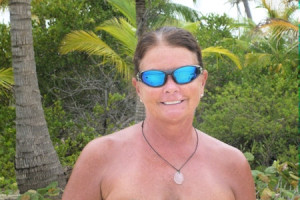
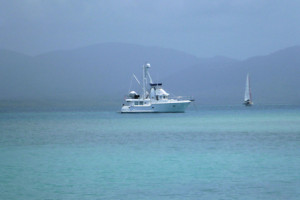
Rosé on the beach Tropical Blend at East Holland Cays
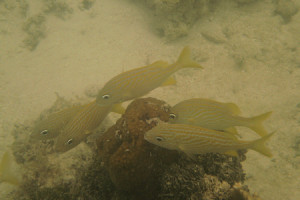
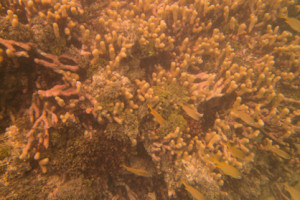
I managed a few underwater reef shots before the DC1400 died
July 19th, 2014: East Holland Cays to East Coco Bandero
Our next stop was Coco Bandero, a group of small cays with a protected anchorage between them and reefs all around them. We had to carefully negotiate the passage through the reef, as the datum on our plotter was off. There were a few boats already anchored, but we found a good spot between reefs, anchoring in about 20’ of sand.
Position at destination: 9°30.7’ N, 78°37’ W
Air temp: 89 Humidity: 71% Water temp: 86
Nautical miles for this leg: 10.5 Total: 4621
Departed at 10:10am, arrived at 12:00pm
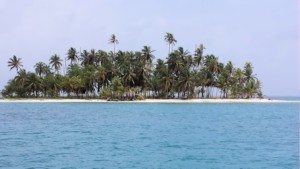
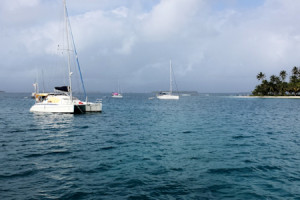
One of the beautiful small islands The anchorage between the islands and reefs
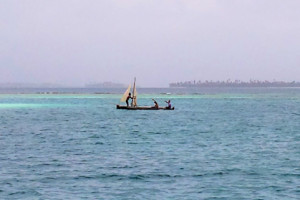
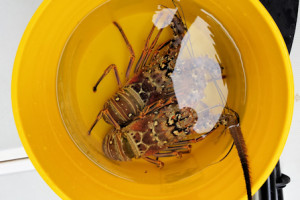
Cayuco with sail Fresh lobsters for dinner
A sailing cayuco came along, and we bought a couple of lobsters. Whenever some Kuna stop by to sell something, after the deal is concluded they ask for something else: soda, water, ice, beer, etc. When you consider how they live, you really don’t mind giving them something else. These guys wanted cervezas, so we passed out a few Balboa’s to them. We grilled the lobsters that night – very yummy!
We kayaked around to the small islands. The bottom is pure white sand, which was covered with large orange starfish. We snorkeled the reefs, which had a decent amount of fish. The Sea Life finally gave out, stuck with the zoom lens out, and refusing to take a charge. I decided to look in to replacing just the camera when we got back to Shelter Bay – rats… This was a beautiful anchorage, and by dark, there were ten boats anchored around the islands. The larger island to the west of us had some huts on it, and it was apparently used for backpackers. Basically, they get dropped off at the island, stay in the huts, and eat whatever the host Kunas are making – probably fish. It’s a cheap way to enjoy the islands.
July 20th, 2014: East Coco Bandero to Green Island
Our next stop was very close by, the uninhabited Green Island. It’s a small island three miles southwest of Coco Bandero, just three miles from the mainland. Supposedly, a supply boat stops in the anchorage to take orders from long-term cruisers. We found a sandy spot to drop the hook on the south side of the island. We saw two other sailboats anchored in the area, and a couple of others arrived after us. The anchorage is large, so there was no crowding. One of the sailboats had two large dogs on board, perhaps Labradors. The owner would dinghy to the island while the dogs swam behind – good exercise for them. We took the kayak to shore and walked around the small island. It’s really just a long finger of land – two beaches with a small coconut forest between them.
Position at destination: 9°28.8’ N, 78°38.2’ W
Air temp: 90 Humidity: 67% Water temp: 87
Nautical miles for this leg: 3.0 Total: 4624
Departed at 11:40am, arrived at 12:15pm
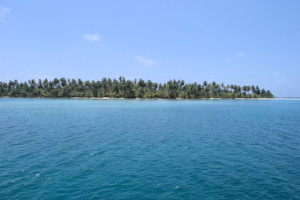
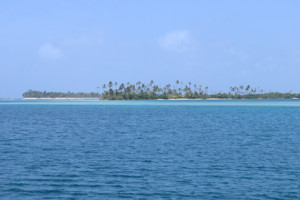
West end of Green Island East end , with Coco Bandero in the background
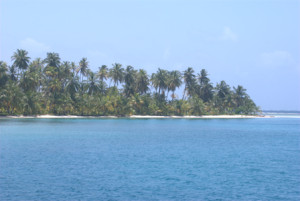
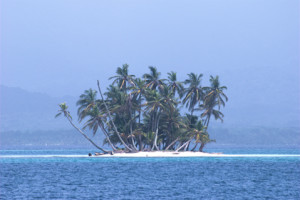
Lots of coconut trees A little sandy spit a few hundred yards to the south
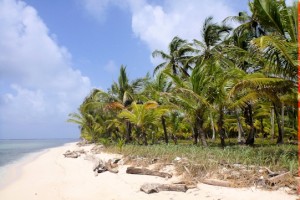
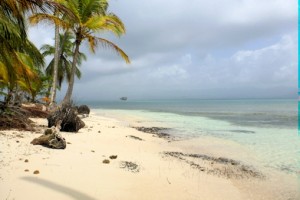
South side beach North side beach
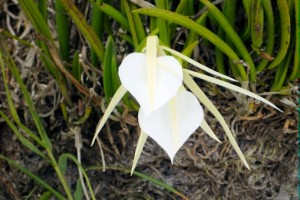
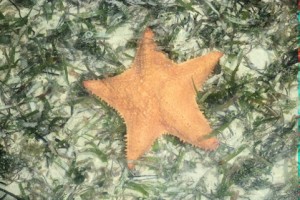
Unknown flower Starfish is in about a foot of water
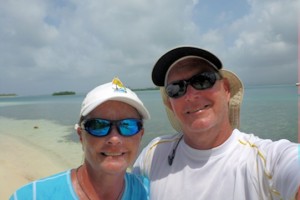
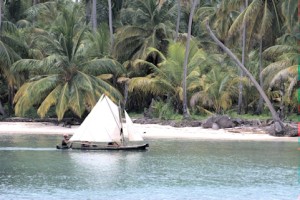
Our Green Island selfie Amazingly, this cayuco didn’t stop to visit us
We decided to stay two nights at this idyllic anchorage. Since our batteries had greatly reduced capacity, we had decided to run the generator all night and enjoy air conditioning while we were in the islands. The second morning at Green Island, Quincy got me up at 6:00AM for his breakfast, and I noticed that there was a cayuco tied to our stern. Inside was a sleeping boy, probably twelve or thirteen years old. I guessed that he had rowed over during the night and was catching a little sleep before fishing. I was going to offer him some drinks, but by 7:00 he was gone.
July 22nd, 2014: Green Island to Dog Island
Since our batteries were due to arrive in a few days, we decided to head back to Shelter Bay. Our first leg took us back west towards the end of the archipelago. Dog Island is between the Lemon Cays and Chichime. We chose this one because it was easy to get in to it, lots of room, and good depth. We just weren’t comfortable with shallow water boating yet. On the way, we did some trolling, and hooked a skipjack tuna. Unfortunately, it drowned before I knew it was on the line. Since skippies aren’t very good eating, I decided to keep it for bottom fishing bait. Later that day I gave it to a Kuna who would enjoy eating it much more than we would.
Position at destination: 9°33.7’ N, 78°51.7’ W
Air temp: 91 Humidity: 69% Water temp: 87
Nautical miles for this leg: 16.3 Total: 4641
Departed at 9:55am, arrived at 12:50pm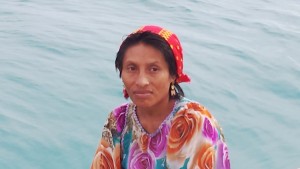
While we were there we were visited by a guy offering molas and jewelry. Rose bought a few bracelets and anklets, but we later realized that this was the second master mola maker, Venancio. Had we known that, we would have looked through his molas. We also bought some more lobsters, and finally we had a visit from the Kuna family living on the island closest to us. They asked us if we could fill their 5-gallon jug with fresh water. Since we still had plenty of water on board and would be going back to Shelter Bay the next day, this wasn’t a problem. Our water 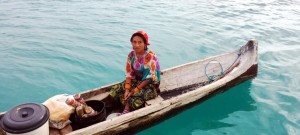 maker had stopped meeting the 500ppm TDS standard, but our tanks were close to full. I figured that it was time to change out the membranes, which might have been the original set for all that I knew. We gave some hard candy to their little boy, and the lady let us take her picture- very striking.
maker had stopped meeting the 500ppm TDS standard, but our tanks were close to full. I figured that it was time to change out the membranes, which might have been the original set for all that I knew. We gave some hard candy to their little boy, and the lady let us take her picture- very striking.
July 23rd, 2014: Dog Island to Shelter Bay
We left at first light in order to be sure to be at Shelter Bay before dark. We had never bothered to check in to San Blas. Our domestic zarpe, which we got when we crossed the canal, was for our original plan. It had us transiting from Balboa to Bocas del Toro, with a stopover in Shelter Bay. We didn’t want to go through the hassle and expense of changing it to a long stay at Shelter Bay, or transiting from Shelter Bay to Porvenir in the San Blas. We were never boarded or checked anywhere in Panama, so this wasn’t a problem. Unlike Mexico and Costa Rica, Panamanian port captains charge varying fees for domestic zarpes – whatever they feel like you are willing to pay. Plus, you can’t get one in Shelter Bay. You either have to pay the marina to get it for you in Colon, or get yourself to the Capitania de Puerto’s office in Colon. Either way, you are out some righteous bucks. We figured we had paid quite enough to Panama already. Even if we were boarded, it would be a matter of a small propina, since we were legally checked in to the country, and we had a valid cruising permit.
Anyway, as per usual, we had a current pushing against us. It seemed that for a long time, 80% of the time we had opposing currents, no matter what direction we were heading in. The ride back was somewhat better, as the sea was quartering our stern. We crossed through the breakwater into Limon Bay around 5:30, with enough time to spare to arrive back at our slip in daylight. We had no problem backing into the slip, as I was getting pretty good at maneuvering it without a bow thruster. Of course, no wind was helpful as well. A couple of guys on the dock helped us with our dock lines, and we were back home again.
Position at destination: 9°22’ N, 79°57’ W
Air temp: 87 Humidity: 74% Water temp: 87
Nautical miles for this leg: 71.7 Total: 4712
Departed at 6:40am, arrived at 6:00pm
July 2014: Shelter Bay Marina
We quickly settled back in to life at Shelter Bay: a little boat work in the morning, socializing at the pool in the afternoon, happy hour at the restaurant, and back to sleep. Wash, rinse, repeat, interrupted by the occasional shuttle bus ride to Colon for groceries and cat food (fried chicken from Popeye’s). I bought some tee shirts and swim trunks from the cheapest department stores I had ever been in. The shuttle bus takes you the shopping center that has a few department stores, hardware, pet food, and electronics, in addition to the large and modern El Rey’s Supermarket. There was a really nice hardware store, Novey, just a little south of the El Rey center – the bus would drop you off there, and it was just a couple of bucks for the cab ride back to El Rey.
The battery saga comes to a successful conclusion
A couple of days after we returned, our final batteries were delivered, and I scheduled the installation with Scott. He had come down single-handed from San Francisco, and arranged to do contract work for the yard while he was there. In addition to free docking and restaurant discounts, he got a free haul-out during his stay. He had a cute little Jack Russell Terrier named Eddie, of course (from Frasier). Scott came over with one of the stronger yard guys, and they managed to remove the old batteries and install the new ones. Given the size and weight of the batteries, and the very limited maneuvering room, it was a very difficult job. Scott didn’t like the quality of the adaptors (round terminals to blades), so he said he was going to order some better ones. Anyway, after we got the batteries installed, we tried the bow thruster, but it still didn’t work. We observed that the batteries were charging, so we waited, and once they got a decent charge on them, we finally had a working bow thruster again. I was surprised that the batteries didn’t come with a full charge – maybe they were sitting on the shelf for a long time. We finally concluded the major boat work, and we looked forward to a relaxing August.
The Great Salsa Carpet Conundrum
When we bought Tropical Blend, it had custom short pile carpeting throughout, to protect the teak and holly flooring, and to provide some firm footing and insulation. It looked pretty sad, but Rosé took all of it home over a few weeks and it cleaned up quite nicely. Now if you own an indoor cat, you’ll know that they and carpeting don’t exactly mix, due to hacking up hairballs on a regular basis. Each time Quincy barfed one up, we had to take it out, scrub it, and hang it over the bow rails to dry. Given its age, this was tough on the backing, which was deteriorating somewhat. We didn’t want to buy new carpet until Quincy took his final cruise (He’s 19 years old, and his kidneys are failing, so he might be shoving off soon).
One morning I was making some enchilada sauce. The recipe calls for some vegetable oil, flour, lots of chili powder, and a few other spices. It’s very tasty, but it does make some nasty stains when spilled. I keep it in the refrigerator in powdered Gatorade container, which have round screw-on lids. I had just transferred the sauce to a container, when I lifted it up by the lid, which wasn’t actually screwed on. It fell, and splattered everywhere: on the salon carpeting, on the cabinet doors, on me, and inside the galley refrigerator grate. That was a triple D’oh! moment. Looking at the incredible mess on the carpet, we decided that this was not a washable item anymore. We would need to replace the salon carpeting.
We asked our friend and line handler Rick if he knew of a carpet store in Colon, which of course he did. We arranged for him to take us, and the old carpet, to the store in Colon. We had indoor / outdoor carpeting in mind, but the store didn’t have that style. Instead, we opted for a modular carpeting that had rubber backing. By modular, it comes in 2’ by 2’ squares, and they are laid in wall-to-wall, staying in place. When an accident happens, you can simply pop out the square, wash it, and reinstall. We arranged to have the entire salon with installation for a little over $400. A week later, they come out on time, cut and installed it.
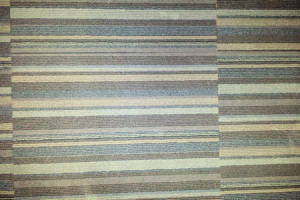
The new carpeting turns our salon into an office building
San Lorenzo National Park and Fort
While we were cruising the Kuna Yala, Pete and Mary had flown to the Galapagos for a vacation. They returned on Tuesday of the week we were hauled out, and they had a rental car for a couple of days. They asked us if we wanted to visit the old Spanish Fort San Lorenzo in the nearby San Lorenzo National Park. The fort was built in the 1580’s to protect the gold shipments coming down the Chagres River. There are no guard rails here, so you have to be pretty careful as you wander around. It’s amazing to think about the manual labor required to build the fort and drag in the cannon.
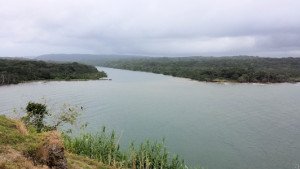
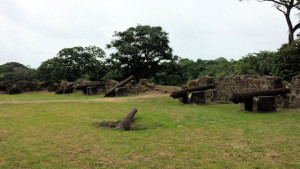
View of the Chagres River mouth Cannon at the fort
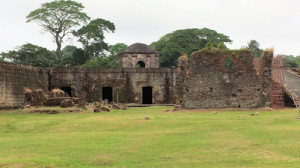
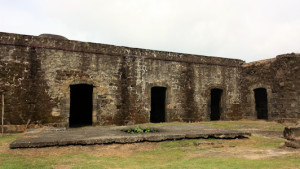
View of the walls from the center We think these were the barracks
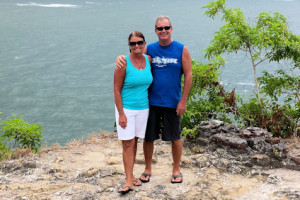

Rosé and Lucky Lucy, Mary, and Pete
July 27th – August 1st: The haulout tests our patience
After the batteries were installed, we arranged our haulout for the first week of August. Our list was simple: power wash the hull, repair the keel damage, bottom paint, change zincs, and wax the hull. The yard said they could get this done in one week, and they would be ready for us on Monday morning, August 4th. They allow you to stay on board in the yard, but with no seawater connection, we couldn’t use the air conditioning, so staying in the hot yard wasn’t an option. There is a hotel on the second floor with nine rooms. Sadly, there is no discount on the rooms when you are having boat work done – another example of lack of coordination and cooperation at Shelter Bay. They also told us it would cost an extra $25 for the cat, but that was only a one-time charge.
Monday morning came and mostly went. The yard was finishing up work on a sailboat, so we had to wait and wait. Finally, a little before noon-word came that they were ready for us. We drove the boat to the yard, and the workers dove on the hull to make sure the straps were correct, and then we were lifted. Once they pulled us into the yard, we jumped off the bow via a ladder, bringing a confused and unhappy Quincy with us. We waited while the power wash was done so we could inspect the keel with Victor, the yard manager. A few days before we hauled out, a beautiful megayacht called Angiamo had docked close to us. It was a 140’ long Feadship, with a beautiful blue steel hull – it sold in 2013 for over $12M. So, while we were watching the power wash, a guy comes walking up wearing an old tee-shirt and shorts, puffing away in a cigar. He started asking us questions about our boat, and professed to love Nordhavn’s. He said that he and his wife think about downsizing, so they can run around naked on their boat without needing crew. He was really admiring Tropical Blend, and I asked him which boat was his. You guessed it, the owner of Angiamo was admiring our little boat.
Victor evaluated the keel, and told us that it could be easily repaired with epoxy and new fiberglass. We hooked up shore power to keep our refrigerators running, gathered up a few things and checked in to the hotel. We had the corner room where we could see both the yard and our slip. Quincy was actually pretty excited to be someplace new, and settled in well. The worst part about being in the hotel was that we would need to eat often in the marina restaurant. It’s not bad food, but the menu is limited, and it’s boring to eat the same things again and again and again. We kept a small cooler in the room so we could make our own sandwiches, and we also had a microwave so we could make some popcorn. At the end of the first day, I went back to Tropical Blend for a few more items only to discover that the shore power had been unplugged, and our brand new batteries were down to 50%. It damages the batteries to discharge them more than 50%, so this was a lucky catch. I taped up all of the power connections to be sure this wouldn’t happen again.
By Wednesday, there wasn’t much progress. The keel had been repaired, but not much else was happening. We expressed our concerns to the yard office, but they assured us it would be finished. We needed to check out of the hotel by Sunday, as it was already fully booked for a film crew that was shooting a documentary at the nearby Spanish fort. We asked about the hull waxing, and we were told that the yard didn’t have any wax, and asked if we could provide it. What kind of yard doesn’t have wax? Our confidence level was not very high. I decided I needed to harass the yard on a twice daily basis. We had heard a lot of stories about frustrated boaters in Panama trying to get work done, and we witnessed firsthand the problems that Neko was having. We knew the yard did good quality work, but apparently “on-time” didn’t translate very well.
By Friday, the bottom painting was underway, but no action on the waxing, even though we had offered our wax. We again met with the yard manager, and it was agreed that they would wax the hull after we were back in our slip, as they needed to splash us on Saturday morning at the latest. That afternoon, when we went back to our hotel room, we noticed a small express cruiser had moved in to the slip next to us. The slips at Shelter Bay are doubles, but we had never had a boat next to us. We were on the west side of the slip. Now, our slip had a Doral express cruiser in its western side, and we could see that they had hooked up to our shore power!
I went down to see why they were horking our power. The owner (Diego) and his family were ex-Venezuelans now living in Panama City. He showed me that the power pylon for his slip was completely disconnected, and he was told to plug in to ours. He was a very nice guy, and the entire family spoke very good English. I went to the office to discuss the problem with John, and he said that he would get the power pylon on Diego’s slip fixed. After further discussion, we decided to relocate to an empty double slip a little further down the dock. It seems that this was Diego’s first boat, 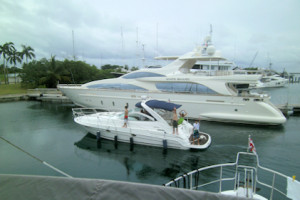 and docking was a mystery to him, so we decided we’d rather be further away.
and docking was a mystery to him, so we decided we’d rather be further away.
After we were back in our new slip, we took some welcome drinks to Diego. He had quite an interesting story. He had been a commercial airline pilot in Venezuela, and one day a teenager broke into his house in Caracas, pointed a rifle at his wife, and declared that President Chavez told him to kill the rich people. Diego’s eldest son stepped in front and took two bullets to his abdomen. He was hospitalized for over a month, but made a full recovery. After that, Diego decided it was time to leave Venezuela, although they clearly miss it a lot. He worked for some time in Panama flying cargo, and had recently retired. They got the idea of running weekend charters to the Pearl Islands. The Doral 360 Express was purchased in Florida and shipped on a freighter to Colon, where Diego brought it over to Shelter Bay. Since we had a lot of experience on similar boats, we helped him to understand its operation and systems. It was well-equipped, with twin diesel V-drives, a diesel generator, air conditioning, and even a bow thruster. I helped him to troubleshoot an air conditioning problem, and he gave me a couple of really good bottles of Venezuelan rum. One night they were celebrating his wife’s birthday, and they invited us for cake, which they assured us came from a Venezuelan bakery. They did suffer one major misadventure – when they took the boat to Cristobal for canal measurement, they dropped the anchor in deeper water and stronger current than they were used to. They watched in stunned surprise as the bitter end of the anchor rode went over the side – the anchor rode had not been secured to the boat! Well, these things happen… Anyway, we really enjoyed the time we spent with Diego and his family, and we wish them the best of luck.




